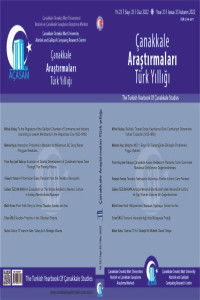Öz
Verimli tarım topraklarına sahip bir köy olarak kurulan Kepez’de 40 yıla yayılan kentleşme süreci boyunca kır yaşamı geride kalmış; yerini küçük ölçekli bir kent almıştır. 1980’den günümüze, Kepez Beldesi ve çevresine yapılan kamusal ve özel yatırımlar beldenin büyümesinde ve mekânın yeniden üretilmesinde etkili olmuştur. 1980’den günümüze kadar belde için farklı dönemlerde mekânsal politikalar üretilerek planlama kararları alınmıştır. Farklı dönemlerde farklı aktörlerin etkin olduğu planlama yaklaşımları kentin mevcut mekânsal formunu almasında önemli yer tutmuştur. Zamanla kırsal niteliklerini kaybeden Kepez, kentsel alanın büyümesiyle birlikte çevresindeki verimli tarım topraklarını da kaybetmeye başlamıştır. Bu çalışma kapsamında Kepez Beldesi’nin tarihsel süreçte geçirdiği mekânsal değişim 1980li yıllar, 1990lı yıllar ve 2000li yıllar olmak üzere üç dönemde ele alınmıştır. Bu çalışma, Kepez’in mevcut mekânsal formunun bugüne kadar alınan planlama kararlarıyla oluştuğunu ortaya koymaktadır.
Anahtar Kelimeler
Çanakkale Kepez Mekânsal Gelişim Planlama Kararları Mekânın Üretimi
Kaynakça
- Çavuş Z.Ç. (2012). Çanakkale’de kentsel gelişimin uzaktan algılama ve gps ölçümleri ile izlenmesi, İstanbul Üniversitesi Edebiyat Fakültesi, Coğrafya Bölümü Coğrafya Dergisi, 15, ss 44-55, Elektronik nüsha ISSN No: 1305-2128
- Çavuş Z.Ç. ve Uysal A. B. (2018). Çanakkale’de Kentsel Gelişme, Yayılma ve Kırsal Alanlarda Etkileşim, Planlama, (Ek 1): 105-117. doi: 10.14744/planlama.2018.85547
- Harvey D. (2022). Sermayenin Mekânları, (çev. Başak Kıcır; Deniz Koç, Kıvanç Tanrıyar, Seda Yüksel). Sel Yayıncılık: İstanbul. Lefebvre H. (2020). Mekânın Üretimi. (çev. Işıl Ergüden). Sel Yayıncılık: İstanbul
- Şengül, H. T. (2001). Kentsel Çelişki ve Siyaset Kapitalist Kentleşme Süreçlerinin Eleştirisi. https://hdl.handle.net/11511/85345
- Turan M. (2009). Türkiye’de kentsel rant: devlet mülkiyetinden özel mülkiyete, Tan Kitabevi
- 6306 sayılı kanun. (2012). Ankara: Çevre, Şehircilik ve İklim Değişikliği Bakanlığı
- 2981 sayılı kanun. (1984). Ankara: Bayındırlık ve İskân Bakanlığı
Öz
In Kepez, which was established as a village with fertile agricultural lands, rural life has been left behind during the urbanization process spanning 40 years; replaced by a small-scale city. Since 1980, public and private investments made in Kepez Town and its surroundings have been effective in the growth of the town and the reproduction of the space. Since 1980, public and private investments made in Kepez Town and its surroundings have been effective in the growth of the town. From 1980 to the present, spatial policies have been produced for the town in different periods and planning decisions have been taken. Planning approaches in which different actors were active in different periods had an important place in the city's taking its existing spatial form. Kepez, which lost its rural characteristics over time, started to lose the fertile agricultural lands around it with the growth of the urban area. Within the scope of this study, the spatial change of Kepez Town in the historical process has been discussed in three periods: 1980s, 1990s and 2000s. This study reveals that the current spatial form of Kepez was formed by the planning decisions taken so far.
Anahtar Kelimeler
Çanakkale Kepez Spatial Development Planning Decisions Production of Space.
Kaynakça
- Çavuş Z.Ç. (2012). Çanakkale’de kentsel gelişimin uzaktan algılama ve gps ölçümleri ile izlenmesi, İstanbul Üniversitesi Edebiyat Fakültesi, Coğrafya Bölümü Coğrafya Dergisi, 15, ss 44-55, Elektronik nüsha ISSN No: 1305-2128
- Çavuş Z.Ç. ve Uysal A. B. (2018). Çanakkale’de Kentsel Gelişme, Yayılma ve Kırsal Alanlarda Etkileşim, Planlama, (Ek 1): 105-117. doi: 10.14744/planlama.2018.85547
- Harvey D. (2022). Sermayenin Mekânları, (çev. Başak Kıcır; Deniz Koç, Kıvanç Tanrıyar, Seda Yüksel). Sel Yayıncılık: İstanbul. Lefebvre H. (2020). Mekânın Üretimi. (çev. Işıl Ergüden). Sel Yayıncılık: İstanbul
- Şengül, H. T. (2001). Kentsel Çelişki ve Siyaset Kapitalist Kentleşme Süreçlerinin Eleştirisi. https://hdl.handle.net/11511/85345
- Turan M. (2009). Türkiye’de kentsel rant: devlet mülkiyetinden özel mülkiyete, Tan Kitabevi
- 6306 sayılı kanun. (2012). Ankara: Çevre, Şehircilik ve İklim Değişikliği Bakanlığı
- 2981 sayılı kanun. (1984). Ankara: Bayındırlık ve İskân Bakanlığı
Ayrıntılar
| Birincil Dil | Türkçe |
|---|---|
| Bölüm | Makaleler |
| Yazarlar | |
| Yayımlanma Tarihi | 24 Ekim 2022 |
| Yayımlandığı Sayı | Yıl 2022 Sayı: 33 |


